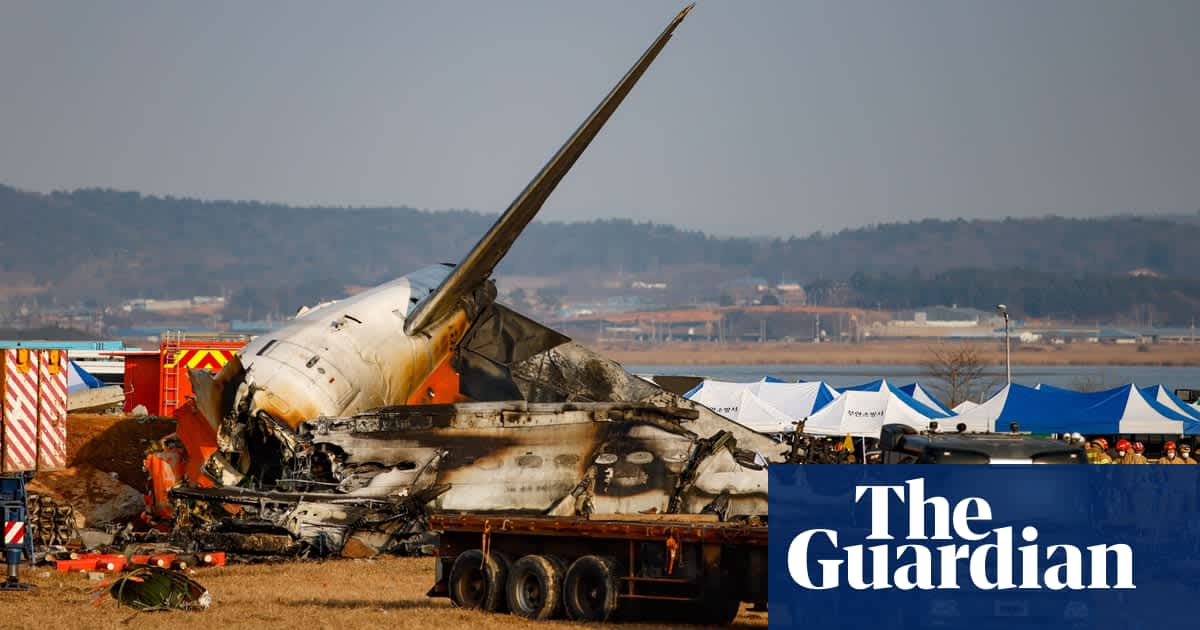Experts say bird strikes are relatively common and should not have been enough to cause landing gear failure
No one knows for certain what caused Jeju Air flight 2216 to crash, killing all but two of its 181 passengers and crew. As darkness fell at Muan international airport in South Korea and officials fielded questions from distraught relatives of the dead, the most likely explanation was that the plane had been struck by one or more birds, triggering a sequence of events that prevented the pilot from deploying the landing gear.
Aviation officials focused on bird strikes – and, to a lesser extent, the weather – as the most probable cause, even as some experts said the relatively common phenomenon would not have been enough to cause a catastrophic failure of the landing gear.
It has been reported that the control tower at Muan issued a bird strike warning shortly before the pilot made a mayday call.
“Staff members all said they had never seen so many birds before. They suddenly flew in from outside the airport,” an anonymous airport official told the South Korean news site OhmyNews.
More will be known once officials have inspected flight data retrieved from the debris of the Boeing 737-800, but aviation experts said a bird strike alone probably would not have carried the impact needed to disable the landing gear.
“A bird strike is not unusual, problems with an undercarriage are not unusual,” said Geoffrey Thomas, the editor of Airline News. “Bird strikes happen far more often, but typically they don’t cause the loss of an airplane by themselves.”
Other experts echoed Thomas’s scepticism. “I’ve never seen a bird strike prevent the landing gear from being extended,” said Geoffrey Dell, an Australian airline safety expert. Trevor Jensen, an Australian aviation consultant, said fire and emergency services would normally be ready for a belly landing, “so this appears to be unplanned”.
Marco Chan, a senior lecturer in aviation operations at Buckinghamshire New University in England, said: “Bird strikes are a significant risk to aircraft, and the danger depends on factors like the bird’s size, the aircraft’s speed, the location of the strike and the engine design.”
Birds weighing up to 1kg “rarely cause catastrophic failures but can damage engine blades or other critical parts”, Chan said, adding that the Boeing 737-800, equipped with CFM56-7B26 engines manufactured by CFM International, was designed to handle many bird strike scenarios.
Birds weighing more than 3kg, such as geese or swans, posed the highest risk, especially if ingested into an engine, he said. “Even smaller birds can cause significant problems at high speeds, particularly if they strike multiple systems. While engines and airframes undergo extensive testing to manage these risks, rare and extreme scenarios remain a challenge in aviation safety.”
Dell said that if a flock of birds had been sucked into the engines, that would not have shut the engines down immediately, giving the pilots time to react.
Footage of Sunday’s crash shows the plane travelling at speed when it made contact with the tarmac. It did not appear to slow down as it careered along the runway and across a buffer zone directly in front of the perimeter wall.
In a typical belly landing, Thomas said, “you are going to land on your engines and you’re going to have a bumpy ride. You come in with minimum fuel, you have fire tenders in attendance, covering the runway with foam, and you land at the furthest end of the runway and usually it ends up being an OK situation.”
Bird strikes typically occur during landing and takeoff and are one of the most common threats to aircraft. A recent study by the US Federal Aviation Administration and the US Department of Agriculture found that 296,613 “wildlife strikes” were reported worldwide between 1990 and 2023, 98.3% of them in the US and mostly birds.
The study found that the number of incidents had risen almost every year. Over the 33-year period, 83 bird strikes had resulted in the destruction of an aircraft, the report said. About 70% of the incidents occurred at or below 500ft above ground level, while those occurring above 500ft were more likely to cause damage.
The airport has recorded the highest rate of bird strikes among South Korea’s 14 regional airports, with 10 incidents reported between 2019 and August this year, according to data submitted to parliament by the Korea Airports Corporation.
A 2020 environmental impact assessment for the airport’s planned runway expansion specifically warned of the risks, noting that “the outer airport area has wide farmland and tidal flats” and that the nearby area was “particularly rich in bird food sources and rest areas”.
Transport ministry regulations require airports with one runway to maintain four dedicated bird control staff, or two staff for airports with fewer than 5,000 flights annually, like Muan.
Nationwide, bird strike incidents have been increasing, from 108 in 2019 to 152 last year. Some suggest the rise could be linked to climate change, with migratory birds becoming permanent residents and shifts occurring in the timing and species of birds appearing at airports.
Source: www.theguardian.com
